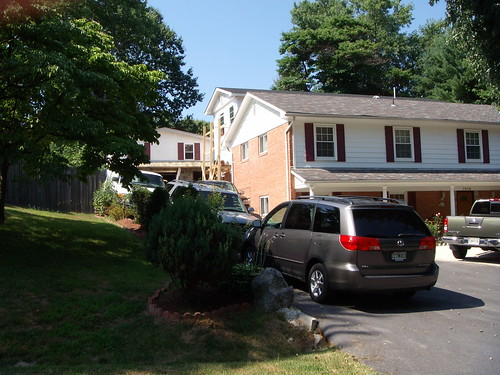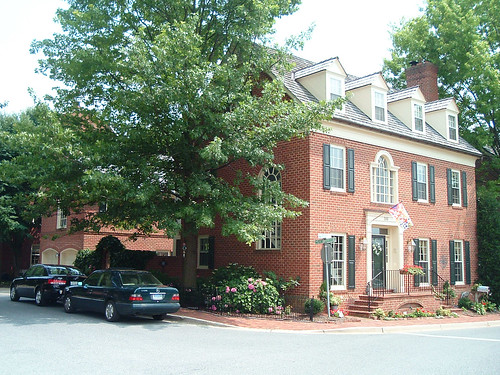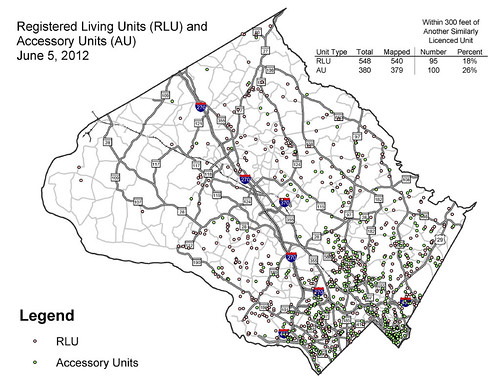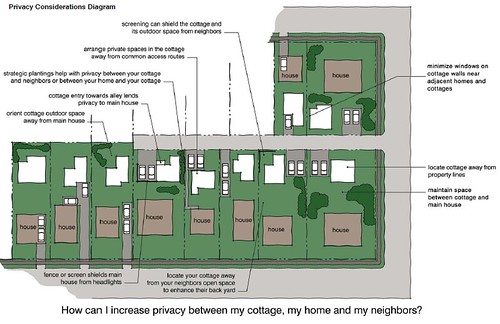 |
| Accessory apartment over garage in Seattle. Photo by studio-d on Flickr. |
Last week, the Planning Board approved recommended changes to the current policy, which the County Council will review this fall. Today, homeowners who want to build an accessory dwelling have to get a special exception from the county's Board of Appeals, which requires a public hearing.
The new policy would allow accessory units on most of the county's single-family zones by default. Homeowners wouldn't need a hearing, but they'd still need to get approval to build an apartment, register their units with the Department of Housing and Community Affairs, apply for a rental license, and renew the license each year.
Planners say allowing accessory apartments will help financially strapped homeowners cover their mortgages while providing additional housing choices for renters, particularly young adults, who are priced out of many MoCo neighborhoods. Accessory dwellings are already allowed "by right" in a variety of communities, from cities like Portland to suburban Lexington, Massachusetts to rural Fauquier County, Virginia.
Opponents fear "devastation"

However, not everyone's on board. WeAreMoCo, a newly-created citizens' group, argues that not requiring a public hearing is undemocratic, while angry residents packed a meeting about the proposed change in May, claiming that it would threaten the character of single-family neighborhoods. In an e-mail to the Planning Board, Silver Spring resident Alice Gilson wrote that accessory apartments would "devastate our area" and eventually "lead to middle class flight."
Some opponents argue that allowing accessory units is a bad idea because the county already can't stop every illegal unit that exists. Many property owners do indeed choose to ignore the application process and rent out apartments without permission, and unknown to the county. Often, these units are poorly built or overcrowded, putting tenants in danger.
Others exist in a sort of legal limbo: the owner may get approval to build an addition with a bathroom but not a full kitchen, exempting them from the permitting process for apartments even as they rent the space out as one. Even legal units can earn the ire of neighbors for being oversized or unattractive, like this this 1,500 square foot "addition" to a house in White Oak.
On the other hand, how could you blame someone for building an illegal unit? The current system forces homeowners to defend their financial or household situation to wary neighbors, reducing the incentive to take the legal route. Residents may not want accessory apartments in their neighborhoods, but they probably prefer legal, vetted units to illegal ones with no regulation at all.
How can we ensure the creation of safe, context-sensitive accessory apartments? We need to streamline the approval process, making it less intimidating to property owners. But we also need to make the guidelines for what they can and cannot build clear and easy to follow, letting neighbors know what to expect when one gets built on their block.
What county planners propose

The proposed policy reduces the legal process required to build an accessory apartment, but it's somewhat more restrictive than the current regulations regarding the size, number, and location of units throughout the county.
Today, homeowners can apply to build a unit as large as 2500 square feet, but the new proposal caps unit size at either 50% of the main house, 800 square feet or 1200 square feet, depending on the size of the house or the lot. The new rules also specify that a house with an accessory apartment has to be at least 300 to 500 feet away from another house with one in order to prevent the "overconcentration" of units. There's also a limit of 3 residents per accessory unit, which didn't exist before.
So-called "backyard cottages," accessory dwellings in a separate structure from the main house, were only allowed on lots larger than 2 acres today. Planners were going to allow them on most lots in an earlier draft of the new rules, but they now suggest allowing backyard cottages only in rural zones with lots larger than one acre. They also aren't considering giving amnesty to existing illegal apartments. Those who have them would have to apply for a permit just like everyone else.
The new rules won't result in a flood of new apartments, as they would include a cap of 2000 accessory dwellings countywide. Today, there are just 380 legal accessory apartments and 548 "registered living units," built for relatives or household employees who live there rent-free. Planners estimate that 0.2 to 0.5 new accessory dwellings per 1000 homes will be added annually. With 163,000 owner-occupied single-family homes in the county, that comes out to between 30 and 80 new units each year, compared to 10 today.
A cap on accessory apartments might assuage the fears of residents who oppose changing the policy. But for those who could benefit from this new source of housing, the new policy doesn't do enough.
How could the rules be improved?

The proposed regulations make it difficult to build accessory dwellings in the areas where they'll have the most impact, which hurts homeowners and renters. However, they should also offer more guidance as to how units are designed, addressing neighbors' concerns about privacy, crowding and aesthetics.
Potential accessory apartment dwellers may want to locate in desirable downcounty communities like Bethesda, Silver Spring and Takoma Park, where housing is often more expensive but close to jobs, shopping and public transit. Not surprisingly, most of the county's existing accessory dwellings are in these places. Encouraging more of them here would put these areas within reach of more homeowners and renters and ideally give them shorter commutes, reducing traffic congestion.
However, the proposed policy limits the number of units that can be created in these areas, by allowing only 2000 units in the entire county and requiring that they're at least 300 feet apart. And because there aren't any one-acre lots in these neighborhoods, the new policy won't allow backyard cottages there, either.
Why should it be easier to build an accessory apartment on an acre in Potomac, far from jobs or transit, than in a neighborhood like Woodside Park in Silver Spring, where homes sit on generous 1/3-acre lots less than a mile from the Metro? They already exist on much smaller lots in neighborhoods like Kentlands in Gaithersburg, which isn't under the jurisdiction of the county's planning department.

Opponents of the new policy might say that accessory dwellings will harm neighborhoods like Woodside Park, but clear, properly enforced guidelines can ensure that new units respect the existing context. Many places that allow accessory apartments offer clear directions on what homeowners can or cannot do. Vancouver, Canada has a "Laneway Housing How-to Guide," which provides examples of accessory units that have already been built. Seattle has a 54-page guide to building backyard cottages, including sample layouts and directions on how to provide parking or maximize privacy. And Portland walks homeowners through the approval process, ensuring that their unit meets all regulations before they apply.
These guidelines should be made with public input so neighbors can help set the rules, rather than fight them in a public hearing. As a result, homeowners get a template they can follow, saving them time and hassle; neighbors know what kinds of additions to expect in their community; and tenants get safe, functional, and attractive places to live.
Accessory apartments give residents freedom
Opponents say that accessory apartments will hurt their single-family neighborhoods. But as Post columnist Roger K. Lewis points out, many of Montgomery County's single-family homes were built for large families. But as households shrink, many of these homes hold just one or two people today. A retired couple living in a four-bedroom house and carving out an apartment for their grandkids or an unrelated tenant isn't "changing" the neighborhood, but bringing it back to the occupancy level it was built for.
Let's face it: Montgomery County is an expensive place to live, and many households are struggling to make ends meet. Making it easier to build accessory dwelling units gives both homeowners and renters the freedom to live where they want and within their means. The county's current policy doesn't prevent accessory apartments from being built, but it does ensure that the creation of more illegal, unsafe, and unattractive apartments. That's a status quo our residents and our neighborhoods can't afford to keep.

10 comments:
Woody Brosnan wrote,
Please stop referring to accessory apartments as "granny flats" unless you think homeowners are charging rent to their grandmothers. A "granny flat" is a Regulated Living Unit and no special exception is required in Montgomery County. An Accessory Apartment is a rental unit for profit.
I proposed the cap. It allows a considerable growth in accessory apartments while giving neighborhoods an understandable reassurance that they won't be overwhelmed with these units. The cap is roughly equal to 1 per cent of the number of single family homes in Montgomery County and can be adjusted in future years.
There is a lot of justifiable concern among civic groups that the department of housing does not have enough inspectors or sufficient powers to inspect these apartments annually, as required by law. The cap allows the county to add inspectors in an orderly manner.
Finally, I still believe there be some public notice required, like a yard sign, so that neighbors can ask for a hearing on very narrow grounds, for instance, if they believe a standard has been violated.
I would hope that advocates for affordable housing would get behind this very reasonable compromise.
@Woody
Not everyone knows the term "accessory apartment," so I thought using the more familiar term "granny flat" would be helpful.
I'm not really sure what a cap on accessory units accomplishes. To me, it doesn't matter that there are a certain number of units as that they're in the right places - i.e., downcounty communities like Silver Spring where there are jobs and transit and a large demand for housing, particularly smaller homes and apartments. That's also why I don't agree with the proximity requirement, at least not everywhere in the county: it's these downcounty neighborhoods that can handle more units, not fewer. It seems patently unfair that one homeowner gets a speedier approval process for their accessory apartment, but the guy next door can't because having two units in the same block is "too much."
Woody, housing in MoCo is expensive. Houses in Woodside Park come close to a million dollars, and even an older studio apartment in downtown Silver Spring rents for $1300 a month. Accessory apartments ensure that more people, renters and homeowners alike, can afford to live in places like Silver Spring and contribute to the life of our community the way established folks like you get to.
Like I said, I want it to be easy to have accessory units permitted, but also to have clear guidelines to follow to ensure a high quality of units. MoCo will have to provide the staff to monitor them. But saying we can't encourage more of this affordable and unobtrusive housing source because we'll have to hire another code inspector is ridiculous. Perhaps concerned neighbors can raise the money to pay that inspector's salary.
I think it's a big mistake to promote Accessory Apartments as part of the solution for more affordable housing or yet another scheme to pack down county neighborhoods. Not many homeowners either need or want to have tenants sharing their property. (There is a fear out there that developers are pushing Accessory Apartments in order to get the county to relax the MPDU requirements.)
But there are some homeowners who find because of economic circumstances that they need the income from an Accessory Apartment to stay in their home. It's for those folks that I'm willing to back a modest change.
@Unknown
If homeowners want the income from an accessory apartment on their property, we can probably assume that they're okay with tenants living on their property.
The proposed relaxation of requirements, review, oversight, citizen input, and recourse represent a broad up-zoning of all single family home neighborhoods in the county to be mixed single family and multi-family neighborhoods.
Despite the platitudes about affordable housing and quaint notions of over-the-garage apartments (think Arthur Fonzarelli), there is not a ground swell of owners of single family homes asking for this. Period.
Yes, I understand that our county is an expensive place to live and that more people want to move here, and I support and applaud transit oriented density (such as is in downtown Silver Spring). But the idea that every square corner of the county must have greater density and that existing residents just need to deal with it is just stupid. Why must single family home neighborhoods be eliminated? To me, that would really reduce quality of life here.
Kentlands was a great idea, and well executed, though I have only visited and have not lived there so I can't say as a resident. But Kentlands is not relevant for comparison or justification here because it was essentially a greenfield development that specifically embraced this concept from the beginning (in fact it was a selling point back then), and did not force a density increase on a big set of existing property owners.
Regarding one of the details, you should know (and report) that the "300 foot separation requirement" only applies within a contiguous block face, separately for each side of the street. Thus, a single four way intersection could have four accessory apartments, one on each corner. Also, because some downcounty blocks are shorter than 300 feet, another two units could be at the far side of each next intersection, physically closer than 300 actual feet.
Stuart
@Stuart
I don't know when the "single-family neighborhood" became so sacred in Montgomery County. According to the last census, less than half of Montgomery County households live in detached, single-family houses, and even fewer own their homes. In fact, many MoCo neighborhoods already have a mix of housing types, including my parents' neighborhood in Calverton, and most of the neighborhoods in and around downtown Silver Spring. I believe we should "protect" the right to safe, affordable housing in a good neighborhood (and allowing accessory apartments does that), rather than bending over to "protect" those people who can afford a single-family house.
Besides, the rules basically make accessory apartments invisible from the street. Detached units have to meet the same setbacks as the main house, while all units have to have an entrance on the side or rear of the property. From the street, it'll still look like a single-family house.
I don't know when the single-family neighborhood became sacrificial.
I'm beginning to think that architecture schools must be teaching that more density is always good and that housing costs must be reduced in desirable areas so more people can live there regardless of the interests of current residents.
Just because more people may want to live near downtown Silver Spring is not justification for adding more density to the present neighborhoods to accommodate them. By the same logic, we'd require Apple to give away iPhones because lots of people want them but some people can't afford them.
Turning to the specific proposal, it seems to me that the current special exception requirement for accessory apartments is working well and that no change is needed. I haven't heard of any mass denial of accessory apartment requests or inappropriate individual denials.
You cite Woodside Park. Woodside Park has several legal approved accessory apartments and an application for another is pending -- without any opposition so far as I know. The current law has worked well in Woodside Park.
But there are some situations in which it would be better not to approve accessory apartments, where they would have a negative impact on the neighborhood or quality of life of existing residents. For example, if parking was already tight and accessory apartments would only add to the problem. Another example could be overcrowded schools, inadequate fire protection, etc. So it seems to me that a careful review and approval process makes sense. I would expect that most applications would be approved, but some shouldn't be.
You close with "Making it easier to build accessory dwelling units gives both homeowners and renters the freedom to live where they want and within their means. The county's current policy doesn't prevent accessory apartments from being built, but it does ensure that the creation of more illegal, unsafe, and unattractive apartments."
First, you forget that by building more accessory apartments without review you may be denying current residents "the freedom to live where they want within their means -- the "where they want" that they already have could be changed to something they don't want. The wants of the current residents are just as important and valid as the wants of those who might desire to move into accesory apartments. We don't owe people the ability to live in a desirable neighborhood they currently can't afford.
Second you say that allowing accessory apartments to be built without review will prevent more illegal conversions. I suppose we could prevent bank robbery, too, by making it legal to go into banks with guns and demand cash. But your argument is falacious on another level, too. The proposal still has limits on the number of accessory apartments and on placing them in one definition of close proximity to each other. So there would still be incentives for illegal conversions, not only to avoid these limits but also because illegal conversions could be constructed more cheaply by ignoring building codes, space requirements, etc.
The proposed law is a bad idea.
@Robert
An iPhone isn't a house. People don't have a right to a phone, but they have a right to housing they can afford in areas convenient to other things they need - shops, transportation, etc. And if we're going to invest millions of public and private funds to redevelop downtown Silver Spring and provide all of those amenities, we should ensure that everyone has the chance to take advantage of them. Otherwise, we're wasting our money and our time. We didn't revitalize Silver Spring just so a handful of folks in Woodside Park could see their property values rise. We did it because Silver Spring will either grow and attract more people and continue to be successful, or to stagnate and see people leave and decline.
Not to say accessory apartments are the deciding factor in whether Silver Spring thrives or dies, but they certainly help. I understand people like their neighborhood (and feel entitled to keep things exactly as they are), but you don't get to pull up the bridge and tell people they can't come. I may not be able to afford a big house like you, Robert, but I work hard and I deserve to live in your neighborhood too.
@Robert
Your comments (at 1500 words) were too long to fit in the comment box, but I appreciate what you're saying. Would you be interested in turning them into a guest post? Please email me at justupthepike at gmail dot com and we can discuss it further.
Post a Comment